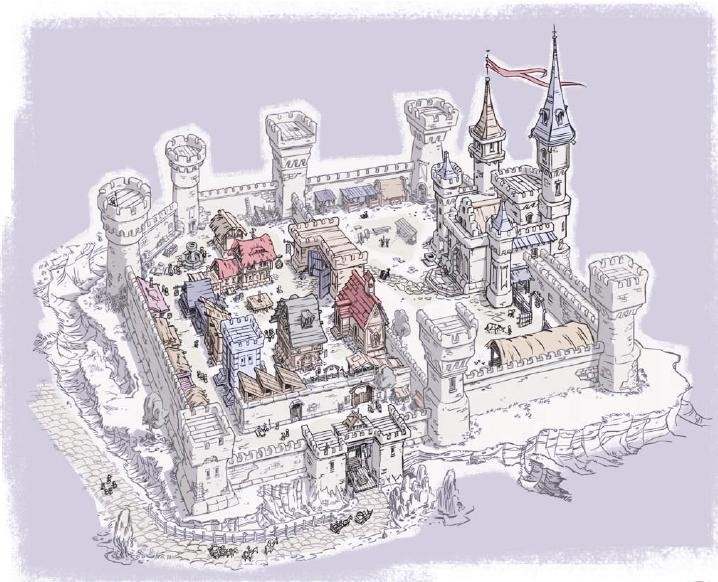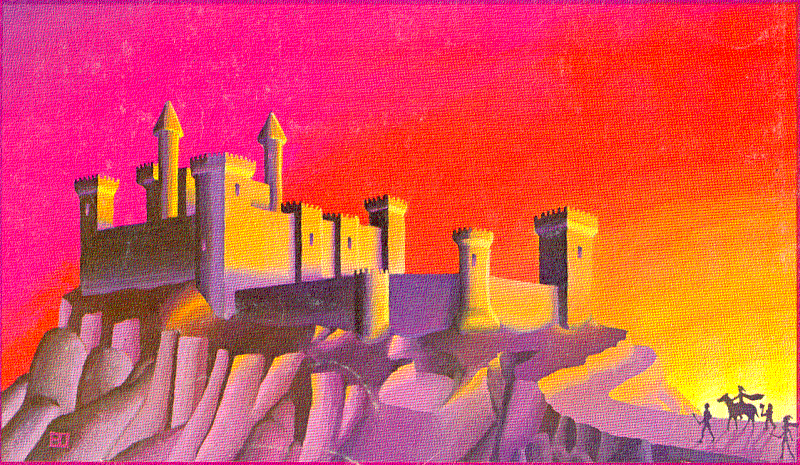The Keep on the Borderlands
The Keep on the Borderlands is a well-placed defensive fortification on the High Trade Road heading east to fabled lands of spices and silk. It has gone by many names over the years of its existence, but it is most commonly referred to by the name of the mountains nearby as Raven's Rock Keep, or simply 'the Keep', though older folk may still refer to it as 'the Abbey', a role it filled briefly during a span of a few dozen years that came to an end with the appointment of the current Castellan. The Castellan is a paid appointee rather than directly a member of the nobility, and because of this, it is a place of military and economic operations rather than much political activity. As part of the defensive chain along the Raven's Rock mountains and the eastern Border Marches, it nominally belongs to Countess Saris Marjoleine's feudal lands, but the nobility stays far away in their settled holdings to the west, leaving the borderlands mostly fending for themselves in terms of food, resources and military protection.
Architecture and Purpose
The design is a three-tier construction of ascending rectangular baileys rising from the south to the north, with the inner bailey at the north end reaching significant elevation above the valley below it. The lower, first bailey is reached by a narrow, easily-defended mountain road and operates as a de-facto town. The upper bailey is reserved for the military garrison, and the highest inner bailey within the upper bailey houses the Castellan and his aides and advisors in the administration of the military forces at the keep and in the surrounding land. Its primary role is to provide some level of protection for farmers raising critically important food crops and domestic animals in the region, and to protect the passage of trade along the High Trade Road - named for its elevation, not its traffic, which is spotty most of the time and nonexistent at night or in bad weather. The secondary role of the keep, becoming primary in the event of an actual invasion or incursion of some kind, is as a bulwark against any organized force that might seek to march over the shifting and vague borders and threaten the citizenry or claim the riches of the Realm. Threats range from individual highwaymen to organized bandit factions, tribes of humanoids and subhuman races, or organized armies from the powerful but distant city-states to the east. The most recent major incursion was a force of Lizardfolk likely attacking from the swamps further southeast to steal cattle and other food after a particularly cold and long winter, two years ago. After repelling the attackers, a patrol from the Keep set out to destroy the lizardfolk camp, but suffered heavy losses in the swamp fighting and slunk back to the keep without a decisive victory. A sullen peace has arisen between the keep and the remaining lizardfolk ever since. The prevailing thought is that a major attack (from lizardfolk or any other threat) is unlikely as long as a sufficiently reliable and large force of soldiers can be garrisoned here, but there is constant pressure to reduce the number of units because of the costs, limits on local resources, and the thought that a unit stuck way out here in the middle of nowhere could probably be put to better use elsewhere in the Realm.Building Materials
The stone used throughout the Keep is a fine-grained grey fleck granite, quarried mostly on-site from the surrounding mountainside. The core layers of the Keep wall exteriors and tower fascia use stone from the deepest parts of the delve, where the granite was found to be even more dense than it is at the surface and higher up the cliff face. The stone is exceptionally hard with a high compression strength, absorbing rather than shattering when subjected to siege weaponry. The stone also takes polish well, leading to a large number of statues, sculptures, a lovely public fountain and several large commemorative plaques, though this also makes it susceptible to soot staining from fires. Granite can be damaged by high heat, so the fireplaces, ovens, forges and the like are lined with firebrick a few layers thick made from the local clay, milled along the riverbank below the keep proper. The internal framing and rafters of the inner bailey are thick timber on an epic proportional scale, but more normal wood framing is used on the town structures of the lower bailey, with most of them made of local brick and only a few permanent granite block buildings. These have defensive ramparts as well. Roofs are generally a fine terracotta ceramic that can hold up to the weather and further reduce the threat of fire compared to thatch or wood. The ornate peaked roofs over the inner bailey are a thin, layered slate that looks like huge purple-black plumage in the sunset, reinforcing the 'Raven' part of Raven's Rock.Defensive Features
The only egress to the keep is through a huge two-towered entry featuring a wide drawbridge spanning a dauntingly deep chasm, two sets of portcullis for trapping or confounding would-be invaders, and two huge gate doors on pivots with stone weights that can be removed, turning the gates into de-facto immovable walls. The entry is pocked with murder holes and arrow slits and can deliver a number of frightful flaming or acidic concoctions onto the heads of an invading force. The towers are manned with guards at all times, and while the more elaborate defenses are generally used only in an emergency, the guards are under orders to question all travelers and to draw up the drawbridge between groups as a security measure to protect the people inside. No visitors are generally permitted to arrive after dark, but a small tent city has sprung up on the far shore as a result of these policies, with a bustling farm market and a number of pop-up inn tents and places that can be rented to sleep in for the night. A small contingent of guards is posted here as well, merely to keep things from getting completely out of hand and little more. The keep has a large but straightforward sewer and rainwater drainage system, and in addition to numerous barrels and devices for catching rainwater, also have a large and well-dug well in the lower bailey. A good well is a necessity for surviving in the event of a siege, and the sewer system is completely separate, and well designed with drops and deadfalls to let sewage flow out but prevent enemies from (literally) slipping in. While the exterior drains may seem invitingly large, the piping at the interior is only a few inches across, impossible for any normal creature to crawl up, and requiring levitation or flight to get across the gaps. The flow of sewage into the swamps is likely something else that the lizardfolk don't particularly like about the keep.Purpose / Function
One of several defensive garrisons built along the eastern border of the Realm, intended as a last stop for travelers from the west, and a fist stop for visitors from the east in times of peace. For the most part it has always operated as a two-tiered village, with homes and shops in the lower bailey and along the road leading to large farms further out - but within the reach of soldiers in times of trouble. The upper bailey has been reserved for the military, except for a period of about 45 years when it was operated as an Abbey under the influence of the Bishopress Queen Theodosia. Upon the ascension of her youngest brother to the throne, the keep was restored to fully military operations and religion was restricted to the quaint chapel in the lower bailey. its stained glass windows were once part of the Abbey, but were moved here when the building was reconfigured into the upper bailey castle by the partition of additional rooms and the rearrangement of some of the interior walls.
Alternative Names
Raven's Rock Keep, 'The Abbey'
Type
Keep
Parent Location
Included Locations
Characters in Location
Related Report (Primary Locations)



Comments